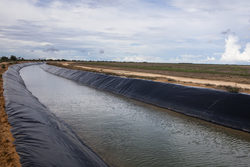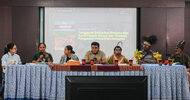Mongabay | 8 February 2021
Pandemic fails to slow agribusiness’s thirst for Cerrado’s water
BY CAIO DE FREITAS PAES | TRANSLATED BY ROBERTO CATALDO
• Between April and November last year, the government of the Brazilian state of Bahia authorized agribusinesses to collect nearly 2 billion liters (528 million gallons) of water a day.
• The spread of giant soybean plantations in the state’s west threatens tributaries, floodplains and sources of essential rivers such as the Corrente and the São Francisco.
• The large-scale irrigation poses a major threat to traditional communities, whose own communal farming practices have long protected the Cerrado’s water resources.
• Tensions over water management sparked a popular movement by small farmers in 2017, known as the “Water Uprising” and aimed at protecting the Cerrado’s water resources.
In November 2017, about a thousand small farmers, cowboys and their families got on buses and headed to the Rio Claro farm, owned by Lavoura e Pecuária Igarashi, one of many companies using large-scale irrigation in Brazil’s Bahia state. They blamed the farm for the degradation of the Arrojado River, which supplies water to their lands in Correntina municipality, 830 kilometers (515 miles) from the state capital, Salvador.
The confrontation turned violent as the small farmers, campesinos, destroyed equipment on the farm, making headlines in the country’s main newspapers. It also sparked an offensive against the campesinos in Congress by the so-called ruralist caucus, staunch defenders of agribusiness interests. But the politicians did not expect the local population to push back. On Nov. 13 that year, more than 11,000 people took to the streets of Correntina to defend the rivers and the Cerrado grassland ecosystem that makes up much of the state. In the more than three years since then, the government has still not responded to the demands of the movement known as the “Water Uprising.”
In August 2020, the Bahia Institute of Environment and Water Resources renewed Igarashi’s water-use license. This allows the company to collect more than 176 million liters (46 million gallons) of water a day from the Arrojado River for the next four years to irrigate the farm at the heart of the popular uprising. This concession alone is equivalent to almost 60 times the water consumption of Correntina’s population.
Irrigation channel supplying the central pivot system for a soybean plantation in the Cerrado. Image by Victor Moriyama/Greenpeace Brazil.
The Arrojado is part of the basin of the Corrente River, a tributary of the São Francisco River. Thousands of peasants still live in harmony with the Cerrado, where cattle roam the chapadões – large plateaus with native forest – and grow their beans and cassava in wetlands and valleys.
“Living here is very good: everything we plant will grow,” says farmer João Barbosa Magalhães, from Correntina’s Brejo Verde, one of the 630 traditional communities spread across Bahia, according to the NGO Instituto Sociedade, População e Natureza (ISPN). Many of those communities are located in the west of the state, in the so-called Gerais, the native Cerrado areas.
Magalhães is 92 years old and still plants sugarcane and beans, besides taking care of fruit trees and some cattle raised collectively by the community. Being “born and raised,” as he says, by the Arrojado, he fosters a sense of gratitude for the wider Cerrado biome. “One lives very well here!” he says.
Today, campesinos like João Guimarães are the guardians of the Cerrado’s water sources in Bahia’s communal pastures. For centuries, they lived in the “Farther São Francisco” area, where the Cerrado abuts a semiarid region and where water used to be abundant.
Eldo Moreira, a member of the Community Association of the Clemente Communal Pasture, also in Correntina, says communal pastures were established after the arrival of agribusiness in the 1970s and 1980s. “As the squatters started to be evicted from their lands, they organized and began to delimit [their areas], fencing off one spring here, another one there, and so it went,” he says, referring to areas of common use to peasants that have been “enclosed.”
Communal pastures survive through collective management of Cerrado areas. The type of farming that the campesinos practice protects water sources by preserving the soil and allowing high water absorption. The community association in Correntina received an award from the federal government for its good practices, but that work is now threatened by the advance of irrigation projects and giant monocrop plantations.
Concessions based on ‘insufficient data’
Rivers such as the Corrente, the Grande and the São Francisco are threatened by the uncontrolled use of water in Bahia. As soybean plantations multiply in the west, tributary rivers, floodplains and springs are dying. It was against this backdrop that the 2017 uprising against Igarashi’s farm developed.
“The attitude of the people in west Bahia is one of critical and political awareness, and the Water Uprising shows that,” says Luciana Khoury, the state public prosecutor. She has worked on socioenvironmental issues in the area for 20 years and points to the urgent need for a water management plan in Bahia’s far west.
Her views are informed by a study commissioned by the prosecutors’ office about the state of the rivers in Correntina and surrounding areas. It reveals a real water crisis, showing that the flow rates of the Arrojado and the Corrente have decreased by 15-20% in the past 13 years. According to the study authors, the state government continues to grant new water-use licenses based on data from 2007, collected by just five gauging stations.
“The data used by the government do not include the water crises we experienced in 2014 and 2015. Those rivers have changed, but the criteria used for concessions are the same,” Khoury says.
The study identifies the source of the problem: “It is clear that irrigated farms are largely responsible for the impacts on the dynamics of the rivers.”
For Eldo Moreira, a member of the association of communal pastures in Correntina, this isn’t news to the community. “We used to make a living out of these waters, to produce sugar, brown sugar candy, fruit, to give water to livestock,” he says. “There was enormous wealth, but we’ve lost it.”
The findings clash with those from a study sponsored by the Bahia Association of Farmers and Irrigators, the main agribusiness organization in the state. That study paints a scenario of water security based on the Urucuia aquifer, which keeps rivers like the Tocantins and Parnaíba alive.
Khoury says she doesn’t believe in the “water abundance” described by that study, authored by researchers from the universities in Brazil and water regulators from Nebraska in the U.S. “The licenses are granted as if we had a lot of water just because of the Urucuia. I won’t even discuss groundwater because there is no [official] data on it,” she says.
The Bahia state government and the farmers’ association of west Bahia did not respond to Mongabay’s requests for comments.
58 million liters a day for U.S. farmers’ irrigation
Conflicting views on water security have not stopped the state government from authorizing more large-scale irrigation. Official records seen by Mongabay show licenses granted throughout 2020, during the COVID-19 pandemic, for nearly 2 billion liters (528 million gallons) a day to be used for agriculture across west Bahia. These licenses were either issued or renewed between April 1 and Nov. 11, 2020.
One of the licenses was granted to Farmers Elevator do Brasil, a company run by U.S. farmers that owns more than 6,500 hectares (16,000 acres) in the municipalities of Formosa do Rio Preto and Luis Eduardo Magalhães, right in Brazil’s soybean heartland and adjacent to Correntina.
In January 2020, Farmers Elevator’s authorization to collect more than 39 million liters (10 million gallons) of water a day was renewed. The water is to be used “for the purpose of industrial supply and irrigation” of 600 hectares (1,500 acres) at the Canto do Rio farm, near the BR-242 highway in Luís Eduardo Magalhães.
An heir to farmers from North Dakota, Todd Kennedy Topp started the company in Bahia in 1991, to attract Midwestern ranchers like himself. Interest from U.S. farmers has grown in the last 20 years, with several arriving in the Cerrado to plant soybeans and other commodities.
Topp was also granted a license during the pandemic. On Oct. 2, the government authorized the renewal of a water-use license for more than 19 million liters (5 million gallos), to be collected “during 18 hours/day for the purposes of irrigation by central pivot” at another Farmers Elevator farm, also in Luís Eduardo Magalhães.
Topp and Farmers Elevator did not respond to Mongabay’s requests for comments.
Industry giants that supply international traders were also granted licenses. One of them is SLC Agrícola, authorized on July 31 to collect more than 37 million liters (10 million gallons) a day from the Rio Grande basin to irrigate crops on its Palmares I farm in Barreiras municipality, also in Bahia’s far west. One of its main customers is U.S. commodities giant Cargill, which bought more than 25% of SLC’s total output in 2019 alone.
SLC Agrícola’s operations have come under scrutiny because of deforestation, fires, and even cultivation of soybeans in illegally acquired lands in west Bahia. But those problems have not affected its business with Cargill, which continued to buy its commodities through 2020, the company told Mongabay.













